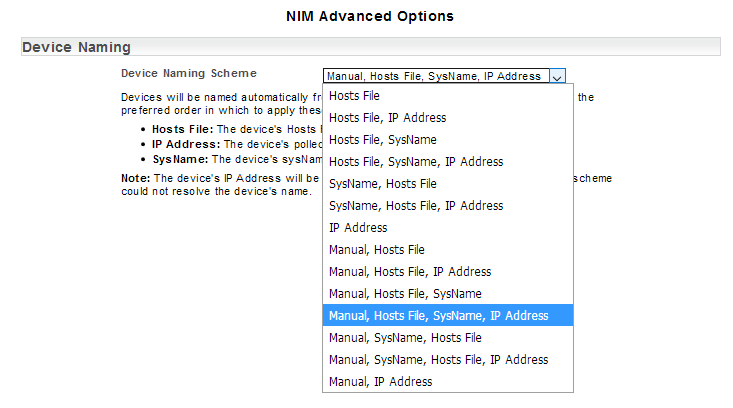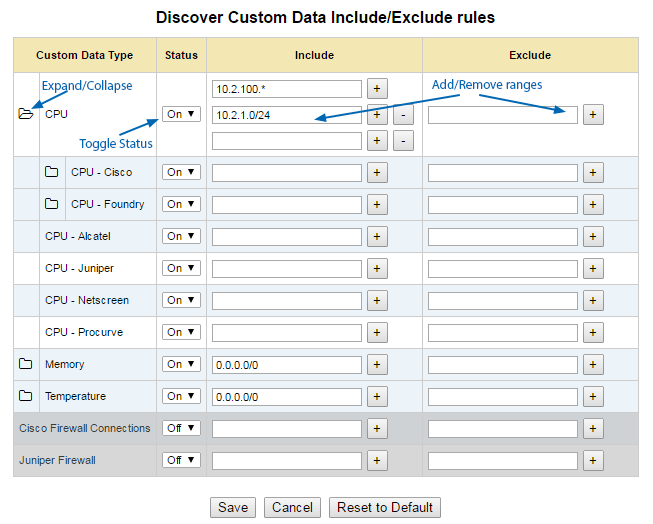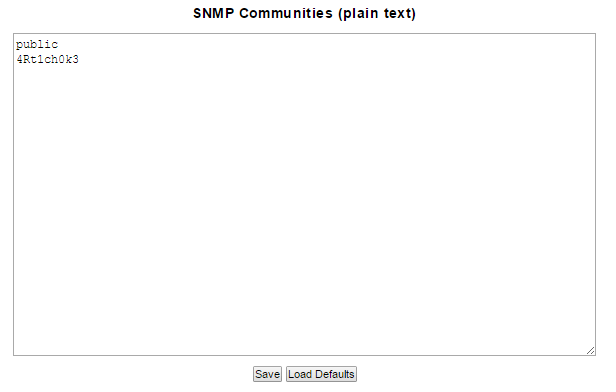Index
- Overview
- SNMP Communities
- IP Address Scan Ranges
- Hosts File
- Device Naming
- Custom Data Ranges
- Breakdown of the Discovery Process
- Running Network Discovery
Overview
SNMP Discovery refers to the process Statseeker uses to:
- Discover devices, interfaces, and other SNMP enabled components on your network
- Collect configuration information from those devices to be used for polling, reporting, and alerting purposes
There are several methods that can be used to direct the discovery process towards the devices on your network that you want Statseeker to report on:
- SNMP Community Strings
- IP Address Ranges
- Hosts File
- Custom Data Ranges
You can also use SNMP Filtering rules to restrict which devices are returned from an SNMP Discovery walk. For more information on this see SNMP Device Filtering.
The rewalk process is a scheduled discovery that only focuses on devices already configured in Statseeker. It does not add any new devices, however it does provide the ability to discover new attributes/interfaces of existing devices. By default, a rewalk occurs daily at 11am servertime.
SNMP Communities
The SNMP Community String is a password-like identifier that is included with an SNMP getRequest to allow/restrict access to a device. Typically, devices feature a default read-only access community string of public.
Statseeker requires read access to the device for polling purposes and the SNMP Communities configuration includes the default community string of public. If your network features devices that have a modified read-only access community string, then you will need to add this string to the Statseeker Discovery configuration. To do this:
- Select Administration Tool > Network Discovery > SNMP Communities
- Add additional community strings, one per line, to the SNMP Communities list
- Click Save
IP Address Scan Ranges
IP address ranges can be used by the SNMP Discovery and rewalk process to define which elements of your network to walk for polling purposes. Multiple address ranges can be defined, 1 per line using the following format:
include/exclude NetworkAddress[/Netmask] or NetworkPattern
Lines can be commented out by inserting a leading hash # and blank lines are ignored.
For example:

Will result in the following address ranges being probed by the discovery process:
10.2.0.0 to 10.2.3.25510.2.5.0 to 10.2.255.25510.13.0.0 to 10.13.255.25510.80.0.0 to 10.80.0.255
To set IP Address Scan Ranges:
- Select Administration Tool > Network Discovery > IP Address Scan Ranges
- Enter include/exclude statements as required, one per line
- Click Save
The scan ranges will be evaluated and the output displayed for you to verify the specified ranges.
The discovery process will scan your network within the defined scan ranges and name devices according to sysname, or IP address if sysname is empty. At the end of discovery it will rename devices according to the contents of the hosts file.
Hosts File
The Hosts File serves two purposes:
- To filter the devices walked in the discovery process, a Discover Using Hosts will only discover those devices listed in the Hosts File
- To ensure that an appropriate name is associated with a device if the device isn't currently configured in a way that will return one
The file lists IP addresses and host names in the following format:
IPAddress one or more spaces hostname
e.g.10.1.1.1 router110.1.1.4 switch1
- Each device must have only ONE entry, for devices with multiple IP addresses, specify the address that should be polled by Statseeker
- Hostnames can only contain alpha-numerics, hyphens and periods
To populate the Hosts File:
- Select Administration Tool > Network Discovery > Hosts File
- Enter IP address and hostname pairs, one per line
- Click Save
Devices specified in the hosts file are added as ping only devices until a Discovery Using Hosts is performed.
Device Naming
Statseeker names devices according to the hierarchy specified at Administration Tool > Network Discovery - Advanced Options > Advanced Options > Device Naming. The default naming convention is Manual Name > Hosts File > SysName > IP Address.

When running a Discover Using Ranges, devices are named according to SysName, or IP address if SysName is empty. At the end of discovery, Statseeker will rename devices according to the specified hierarchy.
When running a Discover Using Hosts, the devices are named according to the contents of the hosts file.
You can set a manual name for a device by:
- Selecting the device (or group which contains the device) in the NIM Console
- In the Reports column, select General > Device Details
- Click the corresponding entry in the Device column
This will open the NIM Edit Device dialog.
- Enter the desired name and click Rename
This records the manually set name against the device's record in Statseeker, it does not write anything back to the device itself. Clicking Reset in the NIM Edit Device dialog will remove any previously set manual name.
Custom Data Ranges
By default, Statseeker will query all devices on your network for any enabled custom data type. By default, CPU load, CPU temperature, memory usage, IPSLA, and UPS statistics are enabled, all other custom data types are disabled. For more information see Custom Data Types.
To assign a discovery range for a custom data type:
- Go to Administration Tool > Network Discovery > Custom Data Ranges to display the associated configuration page
- Click Edit (top-right) to enable configuration
- The data collection Status for a given data type can be toggled On or Off per type, vendor within that type and product within that vendor
- Rules to include/exclude multiple data ranges can be assigned at any exposed data type level in the following formats:
include/exclude NetworkAddress[/Netmask] or NetworkPattern

Breakdown of the Discovery Process
The SNMP discovery process is as follows:
- Ping all addresses defined in IP Address Scan Ranges (only done when discovering by IP ranges)
- Test the SNMP version and community for each device by retrieving the device's sysDescr
- If discovering by IP range, this is every device that responded to the ping
- If discovering by hosts file, this is every device specified in the hosts file
- If discovering by IP range, then use any specified SysDescr Rules to prune this list of devices, for details on this see Filtering using SNMP SysDescr Rules
- Retrieve SNMP Engine ID's for the devices remaining in the list
- Remove any virtual devices from the list, such as Hot Standby Router Protocol (HSRP) devices
- Retrieve the table of IP addresses configured on each device
- Remove any duplicate devices
- Assign internal entity numbers for any newly discovered devices
- Perform an SNMP walk on all devices and from this, build the Network Infrastructure Monitor (NIM) configuration
- If auto-grouping is enabled, assign interfaces to interface type and speed groups as appropriate
Running Network Discovery
To run SNMP Discovery:
- Ensure that you have configured community strings, IP ranges &/or hosts file entries appropriate for the discovery that you are going to run
- Select Administration Tool > Network Discovery > Discover My Network
- Click Discover Using Ranges, Discover Using Hosts or Rewalk as required

The discovery process will begin and the Administration Tool window will display a scrolling log of the process. Discovery time will vary depending on the number of devices being discovered, and the number of grouping rules being applied. A small discovery could complete in a few minutes, however a full rewalk of thousands of devices can take a few hours. For very large networks (in excess of 5000 devices &/or 250,000 interfaces) it is recommended that you contact Technical Support for advice tailored to your network.
Statseeker will begin polling devices once the discovery process is complete. Collected data will be available for display and analysis once polling begins.
- The graphing of collected data requires that there be data from at least 2 reporting periods (i.e. If the data is being graphed at a 1 minute granularity, then you need at least 2 minutes of data before the graph can be displayed)
- Some stock reports default to a Last 5 Minutes reporting period, these reports are only generated for a given device/interface once 5 minutes of data has been collected

